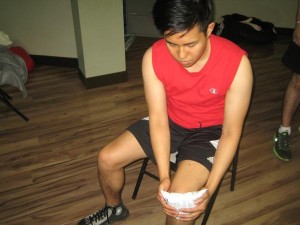Kneecap dislocation occurs when the kneecap or
paella moves or slides out of its original position. The patella is the thick flat triangle-shaped bone covering the knee joint and articulates with the femur (thigh bone). This problem commonly occurs in young athletes, particularly young females. Kneecap dislocation is also called patellar subluxation.
Causes of Kneecap Dislocation
The most common causesof kneecap dislocation are abrupt twisting movement or stress to the knee or direct trauma to the knee.
- Runner changing directions abruptly
- Contact sports, such as football
- Accidental falls from hyper activities including gymnastics, cheerleading and dancing
Symptoms of Kneecap Dislocation
The signs and symptoms of knee injuries are dependent on impact of injury and the cause of the dislocation. The first few times a kneecap dislocation occurs, the person will feel pain and incapable of walking. However, if left untreated and dislocation continues, there may be less pain and disability in the succeeding dislocations. Several signs and symptoms associated with kneecap dislocation include:
- Knee deformity
- Knee stiffness
- Bent knee that cannot be straightened
- Tender and severely painful knee that increases upon movement
- Warmth and bruising in the affected knee
- Swollen knee
- Knee dislocated toward the outside of the knee/ leg
- Hypermobile patella (kneecap can move easily from left to right or vice-versa giving it a sloppy appearance)
- Inability to walk or knees producing cracking sounds during movement
First Aid Treatment for Kneecap Dislocation

Although initial kneecap dislocations would not usually pose lifelong threats, it does not denote that medical treatment or application of first aid upon injury is not required. Call for medical help immediately. Administer first aid in all cases of dislocation, even in kneecap dislocations, to reduce discomfort and pain felt by the person. In fact, it is strongly recommended to give first aid while waiting for medical help to minimize risks for complication.
- Place an ice pack or a cold compress on the kneecap to lessen pain and swelling. This should be done for 20-30 minutes at a time ever three to four hours, for at least two to three days. Do not apply ice directly to the skin as it may cause more complications.
- If possible, straighten the knee. Do not force the knee to moveor attempt to push back the dislocated bone.
- Try to immobilize the knee to minimize movement. If one is trained to apply a splint, do so. A cardboard, rolled-up newspaper or magazine can be used as splints.
- Take pain medications to help ease the pain. Acetaminophen and ibuprofen may be taken.
- In some cases, surgery may be required.
Disclaimer: This article is for information purposes only and not meant to substitute for medical instruction or formal training. To learn more about how to manage kneecap dislocations and others bone-related injuries in the body, enroll in First Aid Courses.
